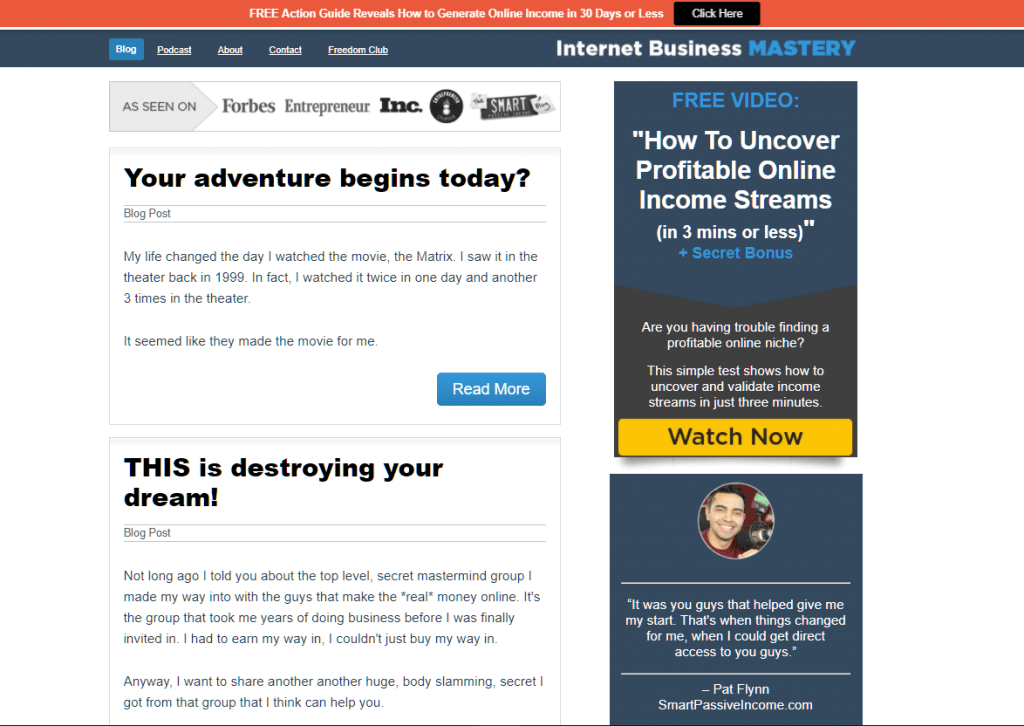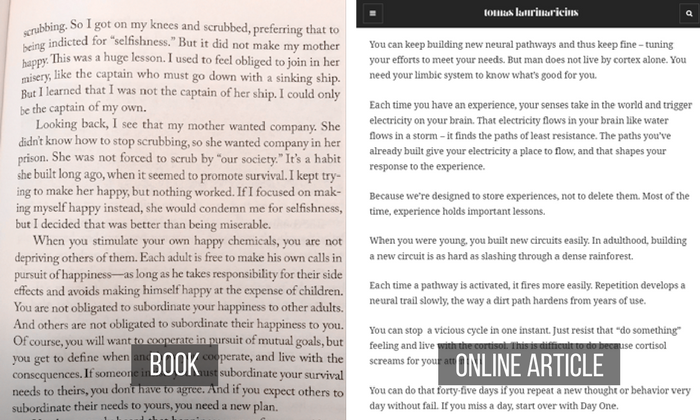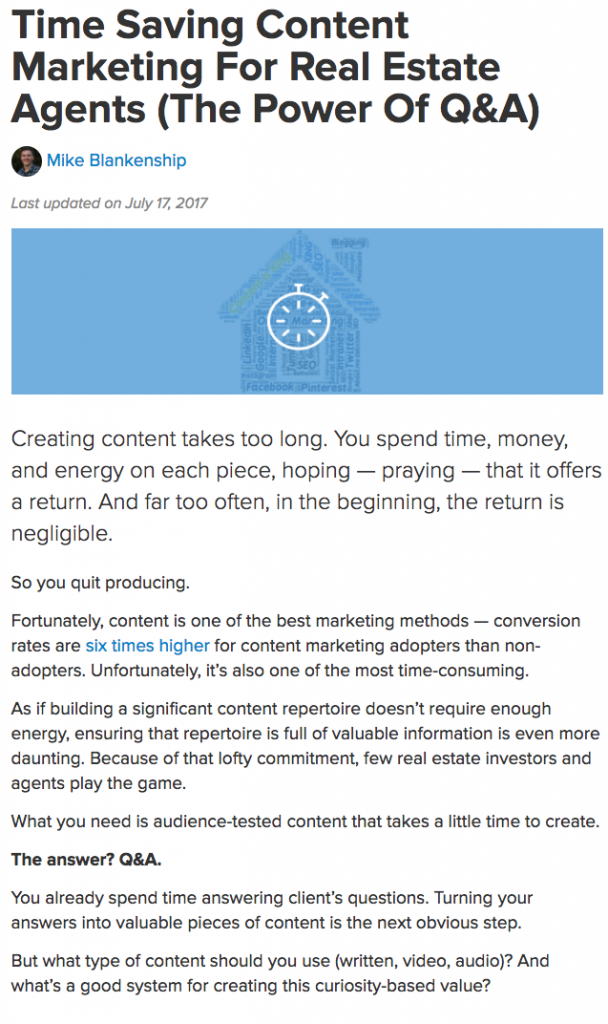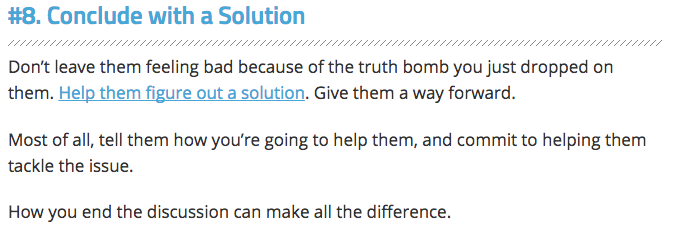Episode: 305
Who: Jason van Orden
Website/Blog: JasonVanOrden.com
Do you ever feel stuck or dissatisfied with your business?
Are you feeling like you need a change, but you’re not sure where to start?
Today, I’m talking to Jason van Orden, who has worked with more than 6,000 students and clients over the past twelve years, teaching them about how to monetize their unique brilliance with content marketing, scalable courses, and automated sales systems. In September 2005, Jason co-founded the first ever podcast about internet business and online marketing, which quickly became one of the top business podcasts in the world and one of the most profitable on iTunes.
Listen to This Episode
He’s also the author of the bestselling book Promoting Your Podcast, and his work has been used to teach marketing at the university level. In case that’s not enough for you, he has also been featured on Forbes.com and Entrepreneur.com.
I brought Jason on today because he and I have been chatting lately about a topic that’s near and dear to my heart. We’re gonna talk about changes that are happening and need to happen in the industry.
Jason’s Story
Jason actually has a double degree in Jazz Guitar and computer engineering. He kind of fell into business and podcastings. He says that he didn’t know he wanted to be an entrepreneur.
Jason Van Orden
Jason enjoys programming (he has done it since age 5), but he really did not enjoy working in a corporate atmosphere. Like a lot of us, he was tired of the “Sunday night dread” and hitting the snooze button a million times.
It was long, zig-zagging journey to find his niche. He was opened up to real estate investment through reading books like Rich Dad, Poor Dad, for example. It was a step by step process. Once Jason realized he was good at real estate marketing, he started teaching people what was then called “information marketing.” This was around 2004, pre-social media and pre-online video, and he was looking for more ways to market his seminars.
So when podcasting showed up in 2005, it was intriguing to Jason for a number of reasons. He very quickly set the goal of becoming “the business podcasting guy.”
His podcast, Internet Business Mastery, very unexpectedly turned into a six-figure business and beyond. It quickly became a primary focus for Jason, and continued to be the backbone of his business until he moved into consulting 2 years ago.

Internet Business Mastery Website
Jason calls his journey a “zig-zaggy, circuitious path.” I think will resonate with a lot of us: you go in a direction, and you don’t know where it will take you. You think outcome will be one thing, but you find out that’s not where you needed to go. So you are constantly changing the plan and reinventing yourself.
Taking Your Own Path
Jason very quickly set the goal of becoming “the business podcasting guy.”
Nowadays, it sounds totally reasonable to start a podcast to help your business. But back in 2005, no one was doing it like that! So I want to know what made Jason go in that direction when no one else was doing it that way. It’s intriguing to me because there wouldn’t have been a mentor to lead him toward business podcasting at the time.
Jason says that he had no reason to think podcasting was going to take off the way it did, except that he had a gut feeling about it. So he followed his gut. And of course, there was a little bit of luck involved. But when I ask him why he went that way, Jason answers, “I almost didn’t, honestly!”
Thankfully, his wife really encouraged him to go for it. She had helped him to process the fear of quitting his engineering job back in 2003, and now she was helping him face the fear of going into podcasting. As Jason emphasizes, it is hugely important to have those advocates in your life, whether it’s your spouse, your mentor, or your Mastermind group.
Making a Change
About three years ago, Jason needed to make some changes. The industry was really starting to wear on him.
Jason needed to make some changes. The industry was really starting to wear on him.
He was living in Paris at the time with his wife and daughter. This was the pinnacle of his lifestyle dreams: he had always wanted to live in Paris, even before he went to college. And he says that he was “loving it.”
But there was a big “but”. All of a sudden, the business he had built wasn’t fulfilling him the way it used to. Keep in mind that his job was advising people to choose their niche carefully because it needs to fulfill you and can’t just be a money maker. But suddenly, he felt like he was not being fed by his work. He wasn’t enjoying it.
Jason says he felt like a fraud: what would his students and customers think if they knew that he didn’t actually enjoy the work himself?
This led to a prolonged period of soul-searching. Jason kept asking, “Why do I feel this way? What’s out of alignment?” He needed to discover what it was that had to change.
His wife stepped in again and recommended taking a retreat. He says that she recognized some of the stuff she had seen over a decade before when Jason wasn’t satisfied in his job as an engineer, and she knew he was avoiding really digging into “the meat of the matter.”
Would Jason say he was depressed at that time? Yes: he says that it “absolutely was the beginning of depression”. He uses the analogy of a frog sitting in boiling water: the feelings of dissatisfaction were slowly eroding “all the things that I depended on as an information-based business owner.” He had to stop ignoring it and putting it off in order to recognize depression.
Give yourself space to get out of your usual element, and to give yourself time.
Now, when you’re a podcaster, you have to show up and perform on a weekly basis. When I turn on my microphone, I know that I have a mission to complete. But when you’re feeling a lack of fulfillment, it must be difficult to show up.
Jason agrees that it took a lot more energy to podcast when he was feeling depressed. He hasn’t gone back to listen, but he’s sure people noticed that the tone of the show was changing. He was mustering energy rather than being excited to share new things.
Jason now realizes that his momentum had ceased. He had been doing same thing for ten years and had gotten complacent. He uses the image of a shark to explain what he means: sharks need to move through water in order to get oxygen through their gills. They’ll suffocate if they don’t move because the water isn’t bringing them that oxygen. That’s how Jason was feeling: stuck and suffocated.
He figured out that he needed to give himself space. When we find ourselves stuck, it can be easy to isolate ourselves. We might be feeling guilty, or shameful and, according to Jason, we ”isolate ourselves from the very input that we need.” Talking to others helps you get “unstuck.” If you’re feeling suffocated, Jason recommends giving yourself space to get out of your usual element, and to give yourself time.
So after he took the retreat his wife recommended, Jason realized he needed more time and took a sabbatical. This allowed him to learn that his drive was gone because he wasn’t being challenged, wasn’t pushing self to master new things. It was time to change some things up, and he had gone too long without listening to those needs.
Getting Unstuck
When he came back to New York City in 2015 to speak to his business partner, Jason was worried. How is the business supposed to survive if they don’t show up and create the content?
Luckily, his partner was feeling kinda the same way. He was very supportive and suggested that they come up with a creative solution to give themselves some time to rejuvenate the business.
In the end, they found a way to just show up to do the podcast and hire someone else to do the rest. This started as a 3-month break, but it became 18 months. Jason continued to make the same money as before, but he only had to work about 4 hours a month. This wasn’t sustainable longer term, but it gave him the room to figure out next steps and reinvent the business.
His advice when you’re feeling depressed, dissatisfied, or stuck?
1. Don’t isolate yourself.
Sharing how hard things have been or how down you’re feeling will help you to unlock and process this stuff.
2. Get out there and have conversations with people.
This should be people you trust as well as new people. You never know who will spark an idea.
3. You're not the only one.
Remember that you’re not the only one that goes through these things (even though it feels like that in the moment). Every entrepreneur has these struggles from time to time.
4. Don’t neglect your mental health.
Our minds are a part of our products, and if your mental health is suffering, so is the value that you create. You’ve got to take care of yourself, too!
Jason also recommends asking yourself questions like these:
- What would be fun to try right now?
- What fascinates me?
- Where do I find my curiosity pulled?
The answers can be hard to find when the market seems to pull you in a particular direction, or when “everyone” is doing the same things. For Jason, moving into one-on-one work was a total change of direction, but it was exactly what he needed to do. He enjoyed it so much that he still does it.
Jason says that if you pay attention to where you get energy and ask yourself what you enjoy, you’ll find what feeds you as a content creator.
It’s easy to get caught up in what everyone else is doing. But just because everyone else is doing it, that doesn’t mean you have to do it, too. It goes back to Jason’s start in podcasting: he started because it was interesting to him, not because it was what everyone else was doing.
Changing the Industry
So I want to know: where does Jason see things that need to change? Or things that derail us and distract us from what’s really important?
He’s got a few ideas! These apply to the industry as a whole, but Jason says they apply to individuals, too:
“The noise floor has just gone up and up and up as more people have come online” trying to sell or establish a brand.” – Jason Van Orden
First of all, we need to realize that marketing is always going to depend on these very sexy stories about the one thing that makes a difference or the story that seems like the overnight success. According to Jason, “the noise floor has just gone up and up and up as more people have come online” trying to sell or establish a brand.
Because of that rhetoric, it’s easy to get caught up in the feeling of “OMG I gotta go and do that. I can’t miss out! #FOMO!” Jason finds this really aggravating. Everyone feels like there’s only one or maybe two ways to do it “the right way.”
That’s just not true, Jason says. Things have become more homogenized online, but there are so many ways to share your voice, show up online, and share your products. We need more innovation in how we create and deliver value.
This isn’t just helping us feel more fulfilled, by the way. The audiences that we’re trying to reach are shifting, too. They are looking for a fresh voice and getting fed up with what’s been done for the last 5 years.
So how do you break the cycle? Here are Jason’s suggestions:
1. STOP Comparing yourself to others.
If that means unsubscribing, do it. Go on a social media fast if you need to, or at least unsubscribe from anyone on Instagram who triggers feelings of anxiety. You do not need to follow everyone in order to “do it right.” Filter out the stuff that doesn’t feed your creativity.
2. Go back to fascination, curiosity, and fun.
Give yourself the space to hear your own approach. If there are hundreds of ways to get where you want to go, you might as well choose the journey that excites you, rather than going with what someone else says because they want you to buy their program. The bar has to be raised because the noise level keeps going up. You can chart your own course.
3. Don’t buy the hype.
We don’t do a good job as human beings to looking back and seeing all the variables that affected us on our journeys. So be wary of anyone saying “this ONE THING made all the difference!” That might be their impression, but it’s probably not true.
I’ve gotta interject for a minute here: this is all crazy talk! I mean, I agree with all of it, but it goes against everything we’re taught when it comes to online marketing.
I believe in everything Jason is saying, but I also have an online course and a membership site, and an ebook. I teach people to blog in a particular way. How do you balance that kind of structure with the knowledge that everyone who goes through a program is a unique individual?
Find a thought leader that you resonate with, that you share values with, that you enjoy listening to, who also has authority, expertise, and experience.
Jason says that he continues to look for answers to this question. We all understand the appeal of a blanket digital course, but evergreen passive income doesn’t really exist. Yes, you want a scalable business and a successful business, but only if it empowers you more and more to pursue your “why”.
Digital courses by nature, end up being created for the “common denominator”: what is the methodology that will work best for most people? Jason has gravitated toward one-on-one work for this exact reason: it allows for more nuance in teaching.
What does this mean for you as a consumer? Find a thought leader that you resonate with, that you share values with, that you enjoy listening to, who also has authority, expertise, and experience. And then understand that there may also be part of what they teach that isn’t wrong, but doesn’t resonate with you or isn’t right for you.
Jason says that he used to be very prescriptive with courses because he wanted people to have the greatest chance of succeeding. Now, he realizes that you also need to make space for people to experiment and make it their own, otherwise they won’t be as successful and fulfilled as they could be. And we need to make clear, as teachers, that that is part of the process.
Frameworks vs Formulas
Keep a healthy balance between teaching a system and making room for individuality.
Jason has a great model (which he borrowed from a friend) for keeping a healthy balance between teaching a system and making room for individuality.
Think about the difference between frameworks and formulas.
A formula says, “just do it the way I did it, and you’ll be fine.” It doesn’t allow for creativity or change.
But a framework is something that can be applied to a number of scenarios that still has room for leeway and nuance. It accounts for a wider range of learners and needs.
So take a look at your content: are you offering formulas or frameworks?
And look at who you’re learning from: are you getting prescriptions (formulas) or flexibility (frameworks)?
Building a Business Model
Jason has some final tips for anyone looking to adjust their business model to help shake things up.
1. Think about positioning.
Find your voice and figure out your ethics. When you read or listen to something online, think about how you would’ve said something similar.
2. Find the best channels to communicate that positioning.
The audience for this podcast is mostly interested in blogging, but challenge yourself to branch out, too.
3. Look at packaging: how do you want to present your knowledge and perspective?
There are alternatives to the digital course model. Everyone right now is talking about funnels and scalables, but that’s all about creating a customer journey.
Those aren’t the only paths. Think about maximizing the value to and value from each student or customer at every point on their journey. Just as there are lots of different customers, there are lots of ways to set up a customer journey that delivers maximum value to them, and therefore maximum income to you.
Remember: there are lots of ways to snap all these pieces together. Jason says that if you’re feeling uncomfortable making a change, remember that it’s not square peg/round hole situation because there are infinite shapes that your business can take. You might have a dodecahedron-shaped business, and that’s great!
Want to know more?
The best places to find Jason are at www. jasonvanorden.com or the Jason Van Orden page on Facebook.
Resources Mentioned
- Jason Van Orden website
- Jason Van Orden Facebook page
- Internet Business Mastery
- Books:
- Promoting Your Podcast– Jason's best-selling book
- Rich Dad Poor Dad
Infographic
The post How to Get Unstuck and Build Your Online Business – Jason van Orden appeared first on Become A Blogger by Leslie Samuel.
from
http://www.becomeablogger.com/25355/jason-van-orden/







